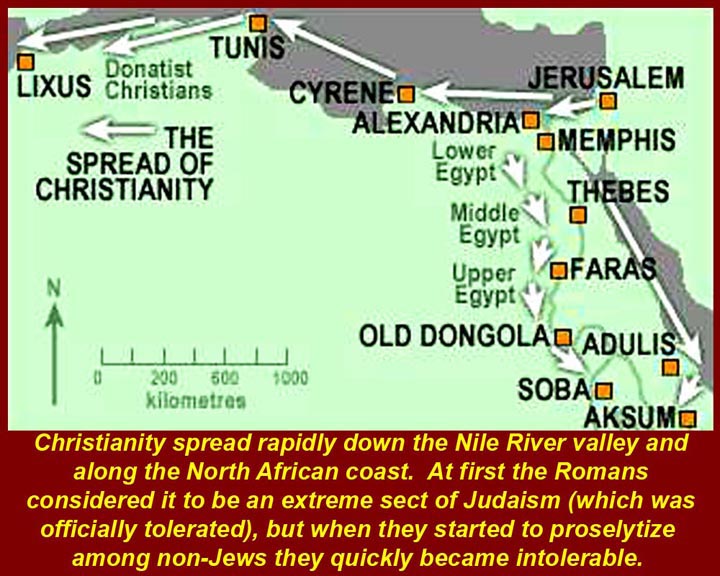
http://www.mmdtkw.org/CNAf0901ChristianitySpread.jpg
Christianity spread rapidly across northern Africa. It appears to have been disseminated by ship borne travelers and missionaries and was
easily and widely accepted.
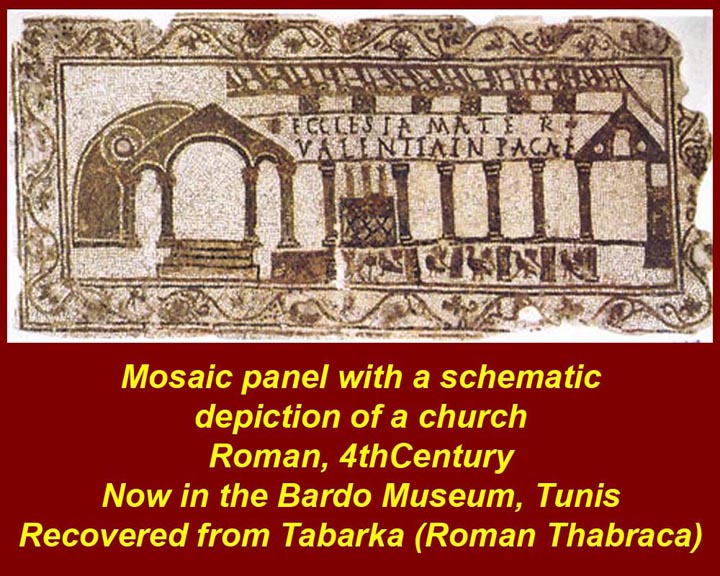
http://www.mmdtkw.org/CNAf0902MosaicChurchTabarka.jpg
In the fourth century, after Constantine's Edict of Milan legalized Christianity, many large churches were built in North African cities. Floor plans of the ruins of the structures and images like the Tabarka church mosaic show that they were Romanesque basilicas. (Although sometimes used to designate any large or important churches, the word "basilica" is really an architectural descriptor: basilicas have a central nave flanked by at least two smaller side aisles -- as in the image shown. The architectural form is derived from ancient Roman civic structures that were often used as law courts.)
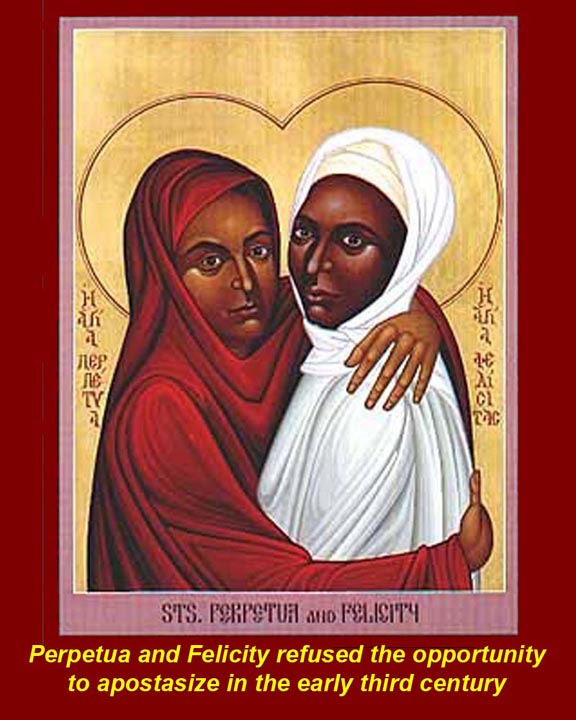
http://www.mmdtkw.org/CNAf0903PerpetuaFelicity.jpg
Perpetua and her servant/slave Felicity were among the earliest recorded Christian martyrs in North Africa (203 AD). The North African church kept careful records of circumstances surrounding important martyrdoms including testimonies written or dictated by the martyrs before their death. Perpetua made two trips to the arena, surviving the first -- netted and tossed by a bull -- and later being put to the sword. Between the two events, she dictated additional testimony about her first arena episode. The testimonies and "passions" (descriptions by other witnesses) were used to encourage other Christians to emulate the martyrs.
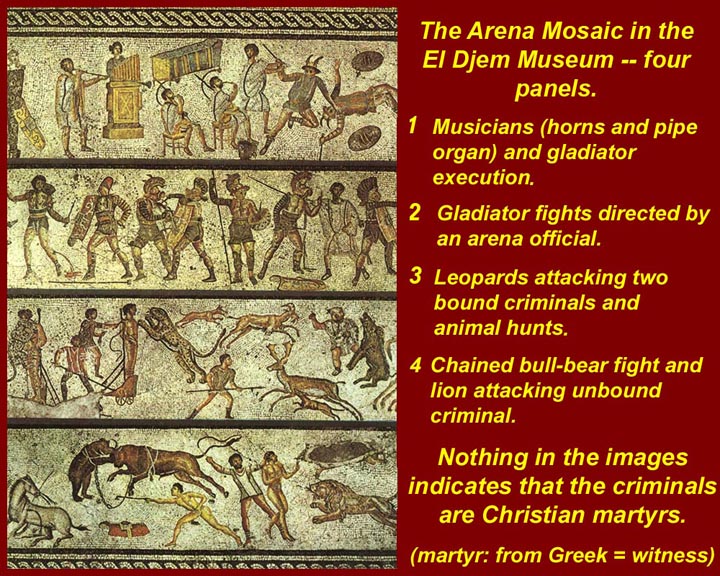
http://www.mmdtkw.org/CNAf0904MosaicElJemMus3rdAD.jpg
Contemporary depictions of arena activities support the descriptions of the martyrs' passions. What is not clear, however, is that victims such as those in the image shown are Christians. Later images that do identify the victims as Christians are all from Christian sources. There is no reason to doubt the descriptions of Christian martyrdoms, however, because there are independent non-Christian descriptions. Most Christians avoided martyrdom either by going into hiding or by doing what the authorities demanded, either by putting the required pinch of incense in the incensarium or by turning over religious scriptures or artifacts. (A third way, bribing an official and getting a false certificate attesting that you had done what was required was also available.) Estimates of how many Christian actually were killed in the persecutions vary with the higher numbers being about 40 thousand in all of the persecutions in the whole Roman empire. The Catholic church number is about 10 thousand. In any case, they were a very small percentage of the tens of millions of Christians that were in the Empire from the time of Nero's first persecution through the reign of Diocletian immediately before Constantine.
Controversy over the avoidance of martyrdom erupted almost immediately with some extremists saying that avoidance was an unforgivable sin and other extremists saying that accepting martyrdom was suicide. Things became even more complicated and bizarre when some martyrs-in-waiting (the condemned) started issuing certificates of forgiveness from their prison cells and when, in some cases, pickets then prevented access to the condemned to prevent them from issuing such certificates.
Enforcement of laws that might lead to martyrdom of Christians was very spotty and there are many instances of local officials trying to find ways to avoid condemning prisoners. Most of these efforts were spurned by the prisoners, who were, after all, actively seeking martyrdom.
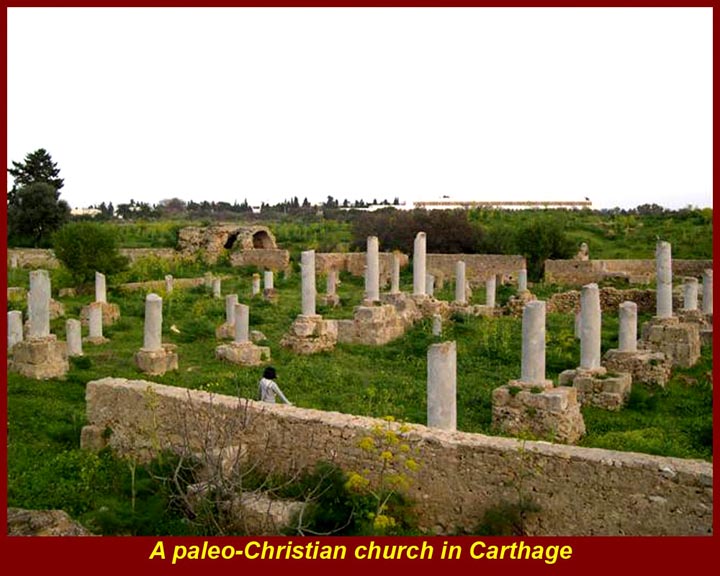
http://www.mmdtkw.org/CNAf0905CarthageChurch.jpg
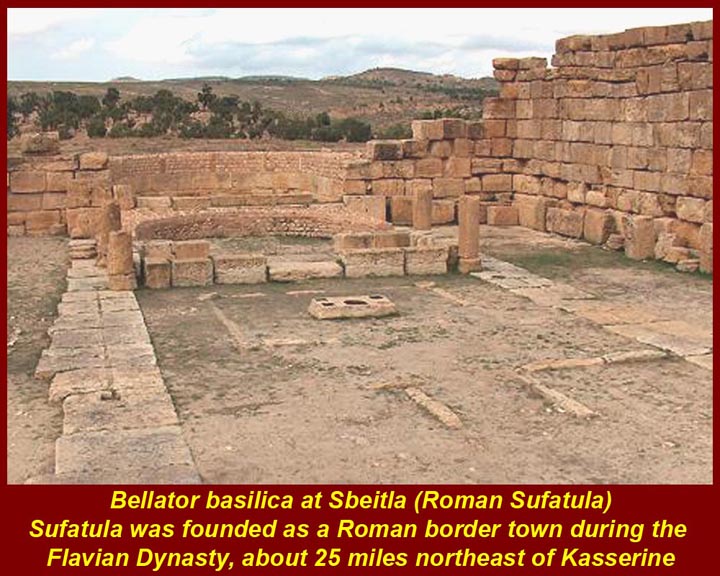
http://www.mmdtkw.org/CNAf0906SbeitlaBasilicaBelatorTu.jpg
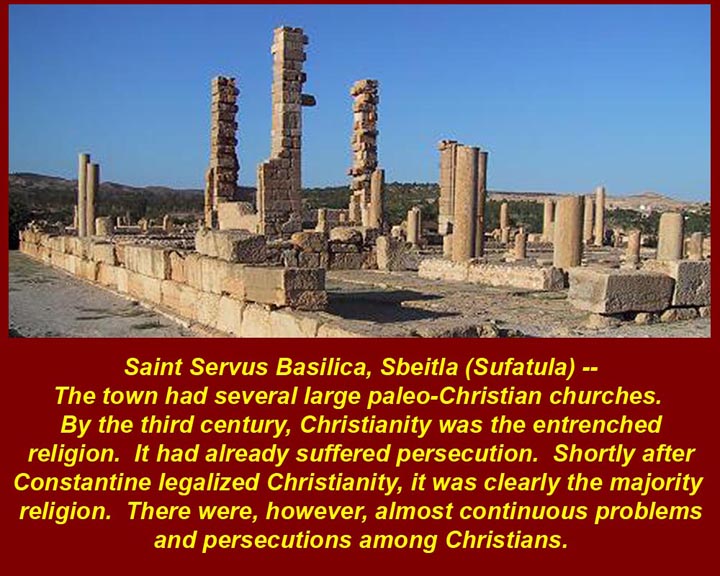
http://www.mmdtkw.org/CNAf0907SbeitlaSServusTu.jpg
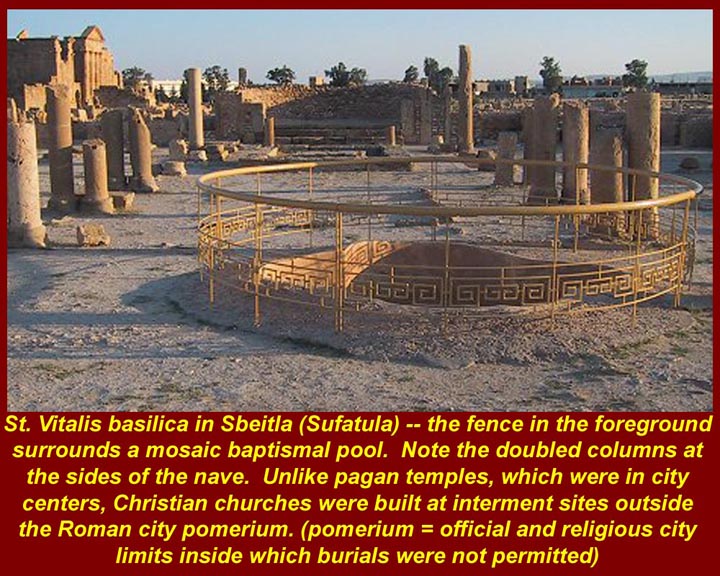
http://www.mmdtkw.org/CNAf0908SbeitlaSVitalis.jpg
Pagan temples in Roman and Roman North African cities were built in the center of town, often at the center of the citadel on the highest hill. Christian churches were built on the fringes and often outside the official Roman city limits: the Romans would allow no burials within their sacred "pomerium", and most churches were built at the site of interment of important martyrs.
Most of the martyrs, by the way, were "important": you either started out that way (preachers, bishops, pamphleteers) or you became important by a highly publicized execution (or "pre-execution") or by being associated with important martyrs (c.f., Felicity and c.f., Cindy Sheehan.)
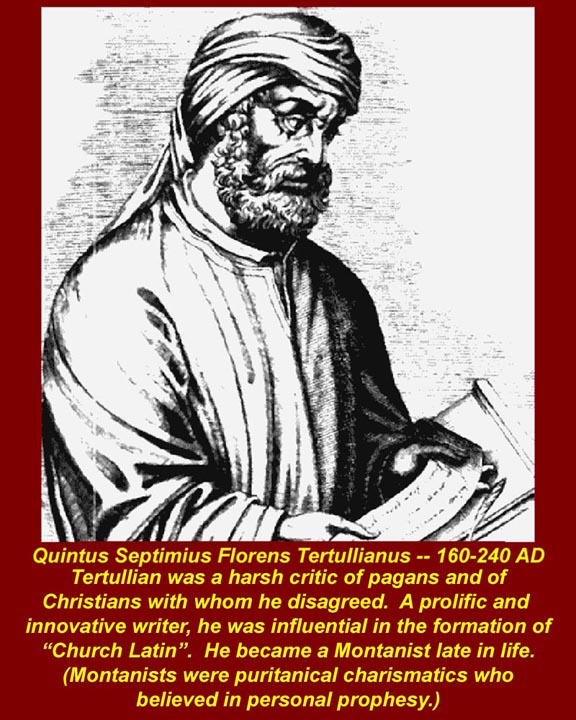
http://www.mmdtkw.org/CNAf0909Tertullianus.jpg
Tertullian (160 - 240 AD) set the Church on the path to the Latin liturgy and was a great speaker and writer, but he was also extremely vituperative, heaping scorn on pagans and Christians with whom he disagreed. He became a Montanist late in life and this heretical belief in personal revelation and prophesy deprived him of his probable position as a "father" of the Church. Note that "heresy" is whatever the power structure defines as heresy.
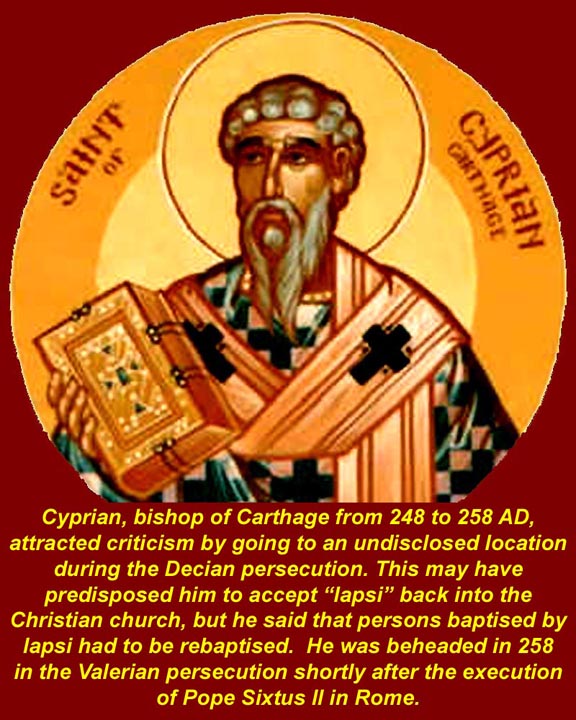
http://www.mmdtkw.org/CNAf0910Cyprian.jpg
Cyprian (bishop of Carthage from 248 - 258 AD) attracted criticism by going to an "undisclosed location" during the Decian persecutions. He accepted "lapsi" back into his congregation but required them to be re-baptised. He was executed during the Valerian persecution after rebuffing suggestions that he hide again.
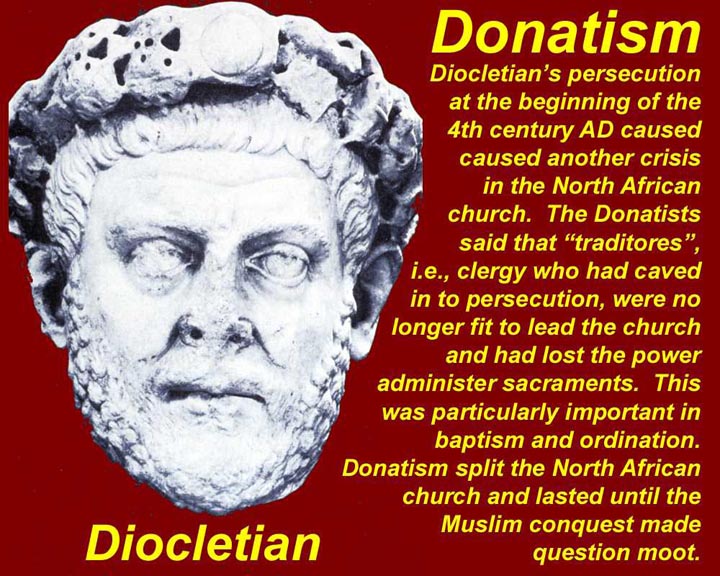
http://www.mmdtkw.org/CNAf0911DonatismDiocletian.jpg
Diocletian's persecution (beginning of the 4th century) led to the Donatist controversy. Donatus and his followers said that "traditores", those clergy and bishops who surrendered sacred scriptures and liturgical vessels on demand, were traitors and could no longer validly baptize or ordain. The Roman Christian church disagreed, and eventually intra-Christian violence and persecutions ensued. The controversy and real schism persisted until the Muslim conquest.
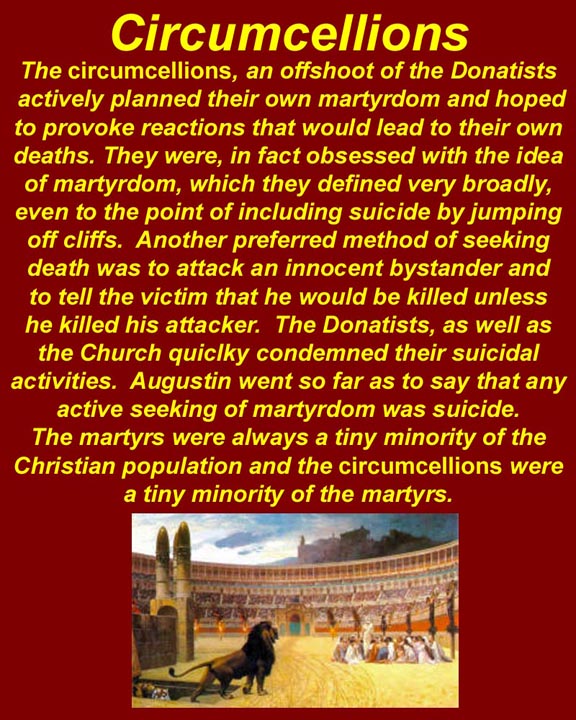
http://www.mmdtkw.org/CNAf0912Circumcellions.jpg
Circumcellions, a radical offshoot of the Donatists, actively pursued their broadly defined "martyrdom". They would attack travelers in the hope of provoking them (sometimes apparently saying, "We'll kill you if you don't kill us."), destroy property in the hope of getting a fatal reaction, defy imperial decrees, and, if all else failed, jump off cliffs (an act that also fit in their definition of martyrdom). The Donatists quickly disavowed them, and both Donatist and Roman Christians denounced them as suicidal and therefore deserving of damnation. Most of the Circumcellions appear to have been either urban or rural destitute persons.
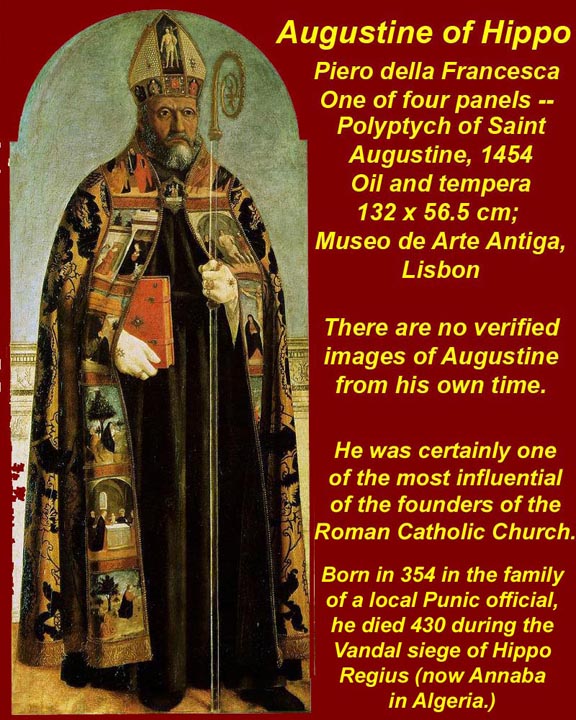
http://www.mmdtkw.org/CNAf0913AugustineHippo.jpg
Augustine was born into an important but impoverished family. A cousin paid for his education in Carthage. He taught there for a while then went to Rome and Milan, where he converted from Manichaeanism to Christianity.
Absolutely the best biography of Augustine is the revised (in 2000) Peter Brown Augustine of Hippo, available from online booksellers. Make sure that you get the 2000 edition which adds a book length update based on most recent research.
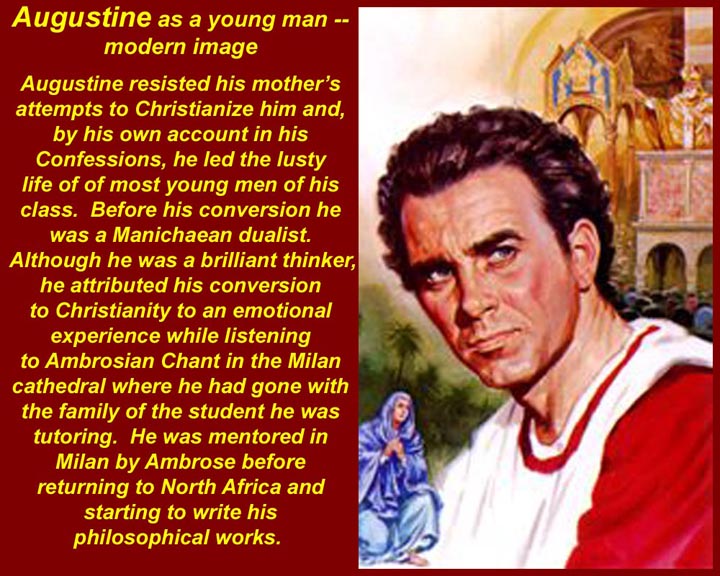
http://www.mmdtkw.org/CNAf0914AugustineConversion.jpg
In his "Confessions", which Augustine wrote late in his life, he chronicled his rowdy and lusty early life and his conversion to Christianity. The trigger for his conversion, he said, was an emotional reaction to Ambrosian chant in the Milan Cathedral. He became a protege of Ambrose and began to write about Christianity. He dropped his concubine at the demand of his mother, Monica, and returned to a quiet monastic life in Carthage. Three years later he became a priest and after another five years he became bishop of Hippo, an office he kept until he died thirty years later.
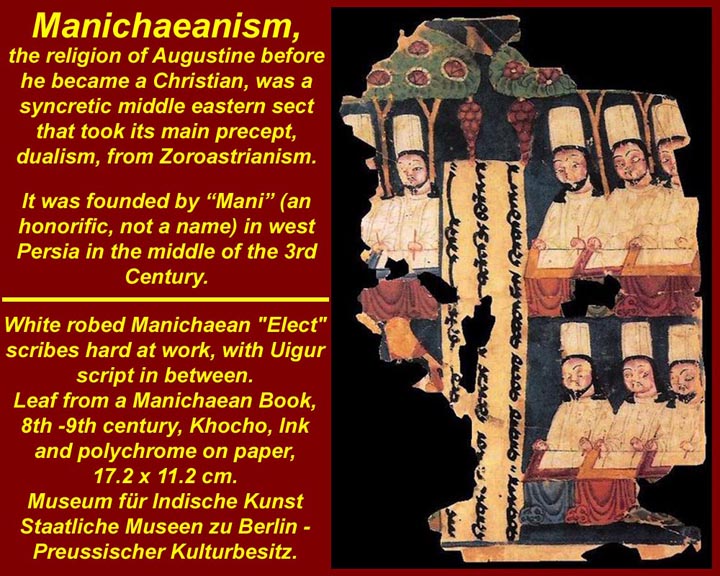
http://www.mmdtkw.org/CNAf0915Manicheans.jpg
Manichaeans were a synchretic Persian sect that took its main precept, dualism (good and evil coequal gods), from Zoroastrianism. Augustine's religion before he became a Christian.
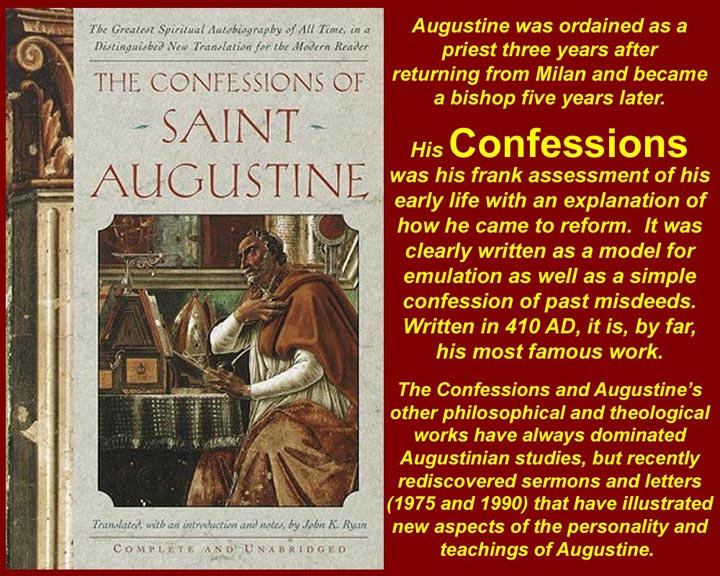
http://www.mmdtkw.org/CNAf0916AugustineConfessions.jpg
Most Augustinian studies concentrate on his theological and philosophical works, especially the Confessions (with undoubtedly some prurient interest), but long lost letters and sermons resurfaced in the last quarter of the 20th century that reveal additional emotional and rhetorical aspects of his ministry.
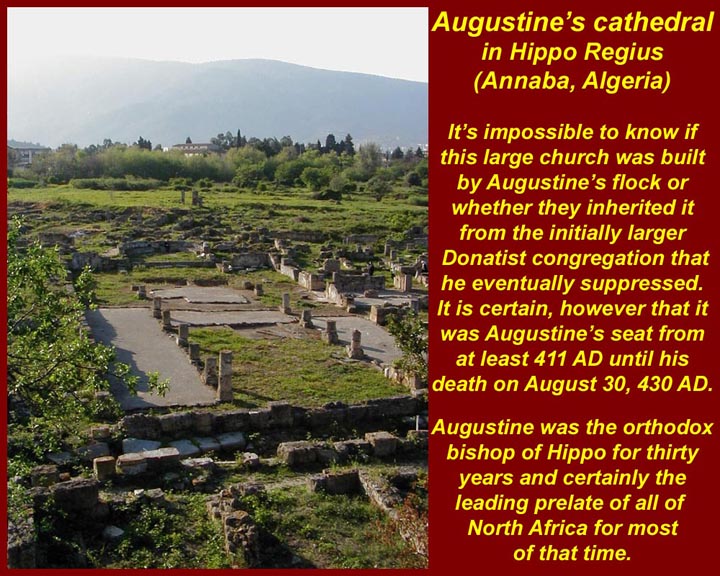
http://www.mmdtkw.org/CNAf0917AugustineHippoCathedral.jpg
Augustine's cathedral church in Hippo regius (modern Annaba, Algeria) exists today only in the pictured ruins. It is not known whether his Roman Christian congregation built the structure or whether they took it over from a suppressed Donatist congregation. Augustine retained his position as bishop of Hippo until his death in 430 AD during the siege of Hippo by the Vandals. The site is maintained by the government of Algeria, but no archeological studies or further excavation has taken place
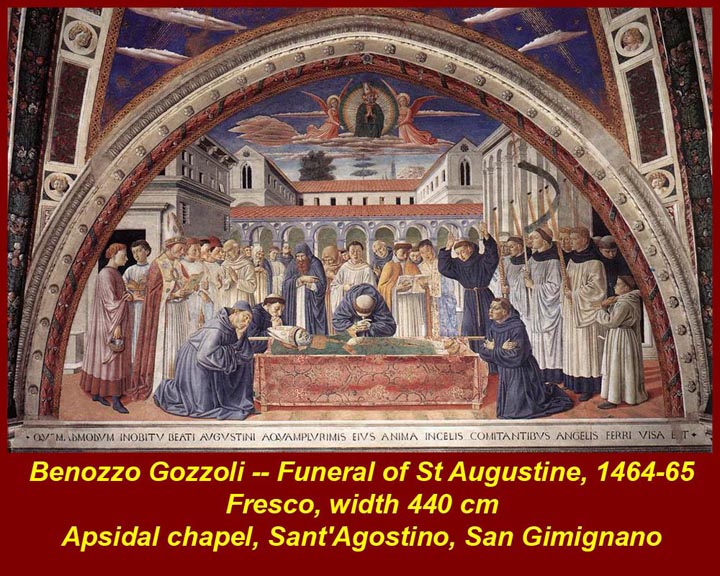
http://www.mmdtkw.org/CNAf0918AugustineFuneral.jpg
The shadow of Augustine's greatness has come down through the ages. Of all the North African Christian notables, he's the only one who is commonly known among educated Westerners, and of all North Africans only Hannibal is better known. In renaissance times, he was widely depicted and was honored in the naming of many European churches. This fresco, which romanticizes his funeral, is in the church of Saint Augustine in San Gimignano, Italy. He is most famously shown as one of the Bernini's bronze statues supporting the throne of Saint Peter in Saint Peter's church in the vatican.
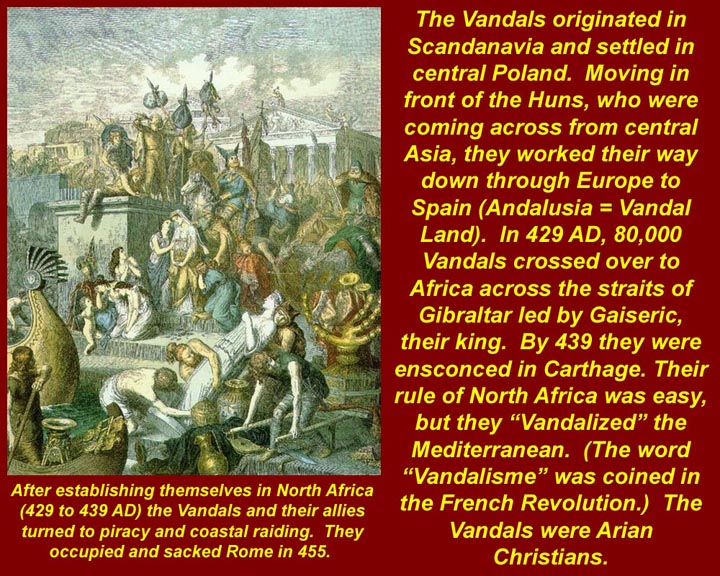
http://www.mmdtkw.org/CNAf0919Vandals.jpg
The Vandals started in Scandinavia before the time of Christ, and, over several centuries, they wended their way through Poland (where the Roman empire first found them) and then down through Europe (moving ahead of and escaping from Goths and Huns) and down into Spain. Under Gaiseric, some 80,000 of them sailed across the Straits into northern Africa in 429 AD. The next year they besieged and took Hippo Regius, the second largest city in northwest Africa, and ten years later they took the largest, Carthage. The Vandals ruled a truncated state (the old Roman Africa Proconsularis -- northern and central Tunisia) for 100 years until they were ousted by Belisarius for the Eastern emperor, Justinian. The most important things to remember about the Vandals are:
1. They didn't destroy the Roman civilization of North Africa. Their aim was to live the high life of those they replaced at the top.
2. They did dispossess and replace the Roman upper class, and they replaced the Roman Christian North African hierarchy with an Arian Christian hierarchy. (This same process was also being carried out by other Germanic groups in most of Europe. Odoacer an Arian Goth was to take Ravena and depose the last western emperor in 476.)
3. They were rapacious pirates and raiders, all over the western mediterranean and occasionally even on Greek coasts in the eastern Mediterranean. But by the end of their hundred years, they had a lot of hired help doing their dirty work.
4. By the end they were soft and debilitated -- just as the Romans they had displaced had been. Belisarius was surprised at how easy his reconquest for Justinian was.
5. The words "vandalism" and "vandalize" got their modern meanings in the French Revolution.
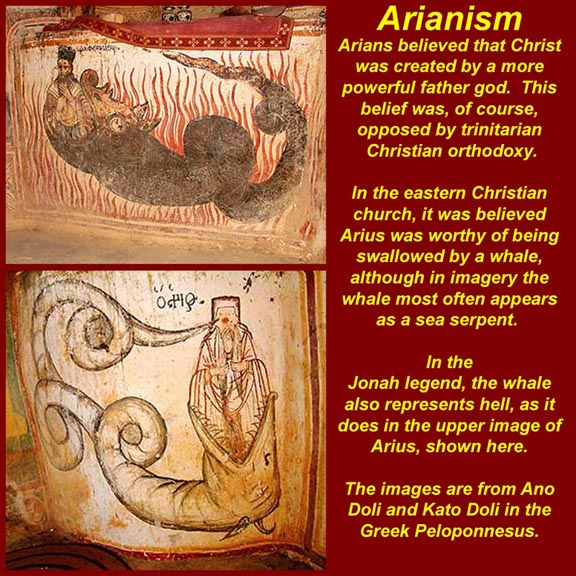
http://www.mmdtkw.org/CNAf0920AriusWhale.jpg
The main point of contention between the Arians and the Roman Christians was that the Romans said the son (Christ) had always co-existed co-equally with the father and was "begotten not made". Arians said the son had been created by the father and therefore was inferior, but still was higher than any other creature and still was "divine." Constantine held the Council of Nicea in 323 AD to settle this question in favor of the orthodox Roman view, but the "heretical" Arian view continued to hold sway with the Germanic barbarians. Within the Roman Empire Arians were persecuted (to death) and, when the Arians took over the west and northern Africa, they returned the favor. The Arians and orthodox see-sawed several times, and, since the orthodox finally won, the Arians were declared, ex post facto, to be the "bad guys" even though there atrocities were no worse than those of the other side. (Note that "orthodox" -- lower case -- refers to Roman Christian orthodoxy: the eastern Orthodox churches -- upper case -- came several centuries later.)
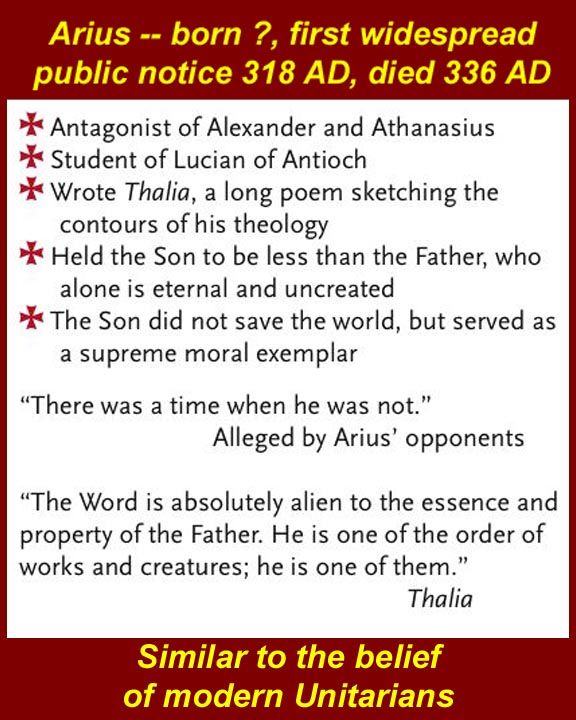
http://www.mmdtkw.org/CNAf0921Arius2.jpg
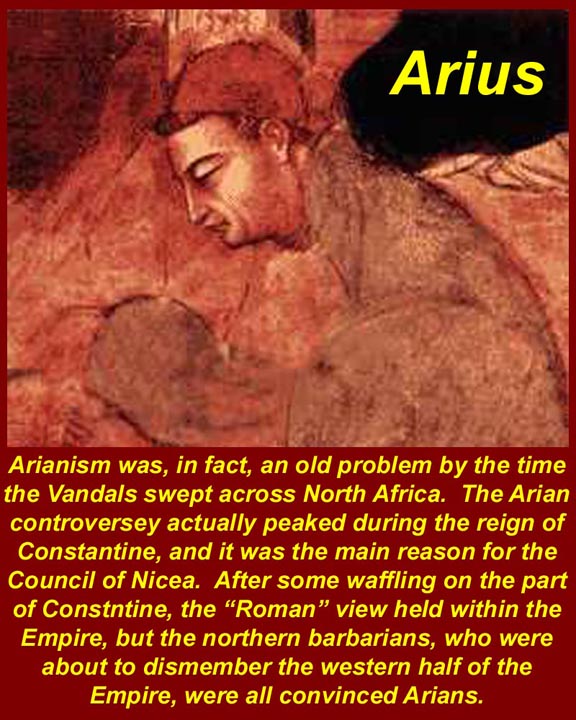
http://www.mmdtkw.org/CNAf0922Arius3.jpg
Arius and the Arians
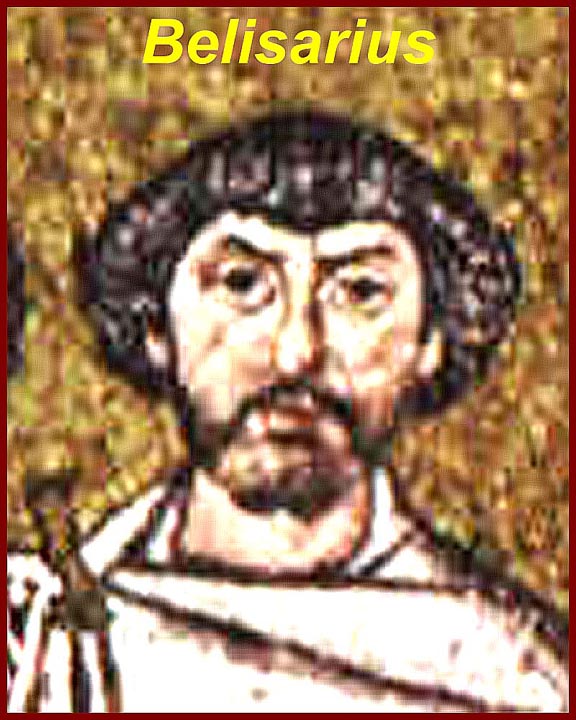
http://www.mmdtkw.org/CNAf0923Belisarius.jpg
As long as Belisarius remained in North Africa, things went well, but Justinian needed him to reconquer the other parts of the old Roman empire that also had fallen to Arian Barbarians. Belisarius was quite successful wherever he went, but his departure from North Africa left its rule to to much lesser men, some of whom were political hacks, some of whom were unskilled relatives of Justinian and succeeding eastern emperors, many of whom were corrupt, and some of whom were all of the above -- political hacks who were unskilled and corrupt relatives.
There were also systemic economic problems after the Byzantine reconquest. The Vandal goal had been to enrich their life in North Africa by exploiting the victims of their raids and of their piracy: cash flowed into North Africa. The Byzantine goal, on the contrary, was to exploit North Africa to enrich Byzantium and to pay for the Byzantine wars of reconquest: huge amounts of cash flowed out of North Africa. So much cash flowed out that even the Byzantine garrisons were often not paid: that led to mutinies and refusals of Byzantine forces to defend the territory. Contrary to the claims of some histories, it appears that Byzantine North Africa was an economic shambles -- it was very profitable for the Byzantines (and their tax farmers), but the people were progressively impoverished.
When the Muslim Arabs arrived, there was little resistance from the locals. It took the Muslims three tries to take all of North Africa: they had internal problems that delayed them twice, and the Byzantines sent out Greek armies to oppose the Muslims. Despite the Byzantine Armies, Carthage was taken and burned to the ground in 693 and was not rebuilt for another 200 years. The Byzantines were permanently forced out of that part of North Africa, but a short-term "Berber" rebellion against the new Arab overlords sent the Arabs into retreat again. The Berbers were inhumane rulers, however, and when the Arabs returned to what is now Tunisia in 698 as permanent conquerors, they were received as Liberators.
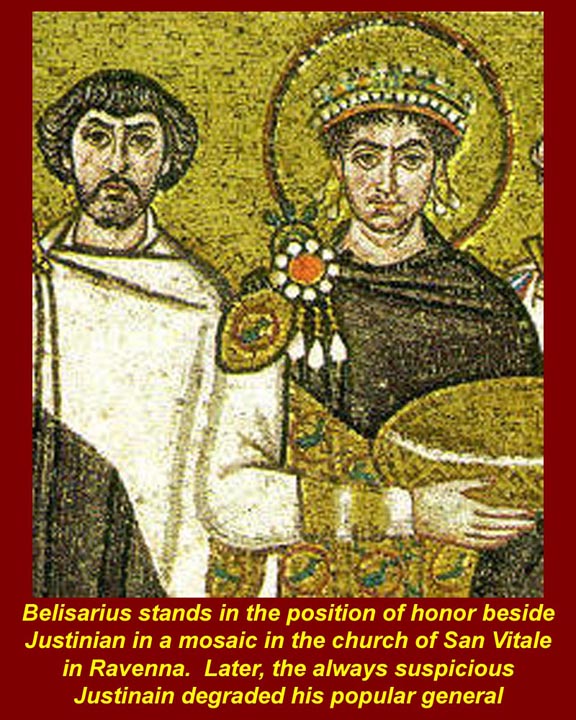
http://www.mmdtkw.org/CNAf0924BelisariusJustinianRavenna.jpg
Belisarius was Justinian's favorite general, but Justinian always regarded him (quite rightly) as a threat. Theodora, the wife of Justinian, was able to save Belisarius on occasion, but he was finally degraded. Contrary to legend and to several famous French paintings, Belisarius was neither blinded nor beggared.
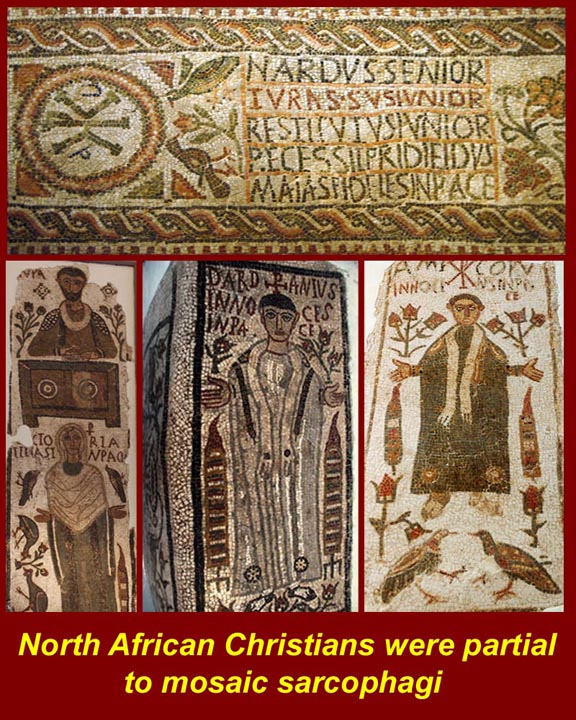
http://www.mmdtkw.org/CNAf0925SarcophagiLidsTun.jpg
Distinctively North African mosaic sarcophagi
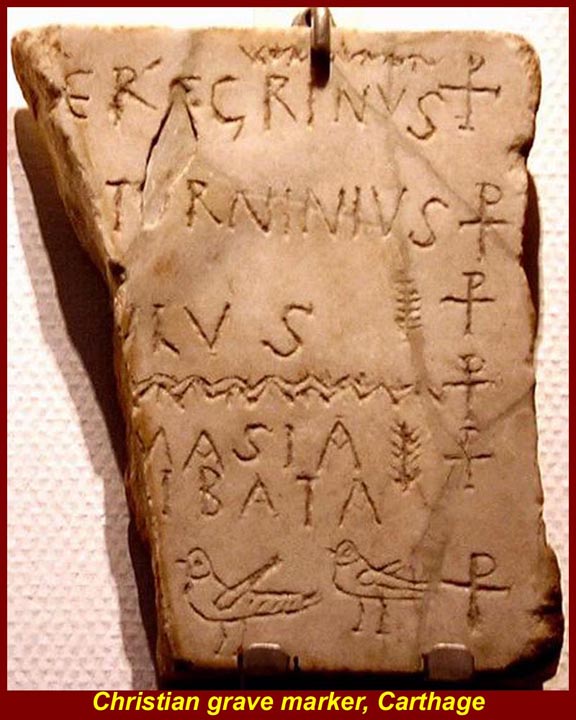
http://www.mmdtkw.org/CNAf0926XtianTombstoneCarthage.jpg
Part of a Christian tombstone from Carthage.
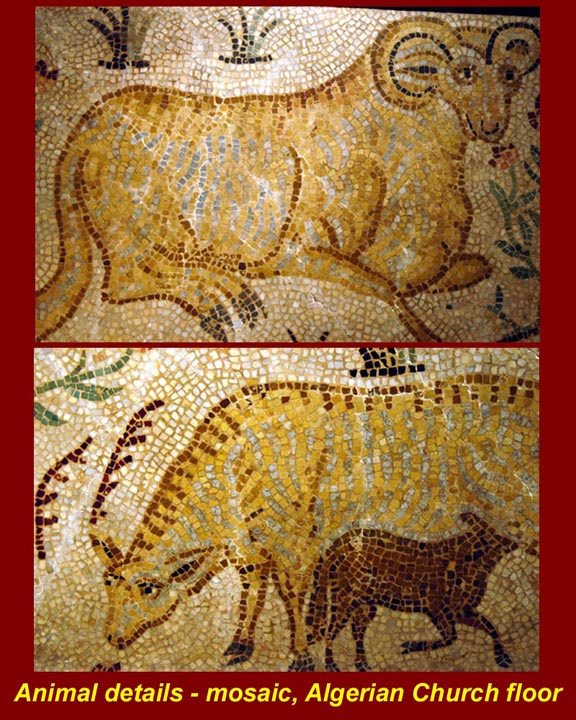
http://www.mmdtkw.org/CNAf0927ChurchFloorMosaicAlg.jpg
Details of a church mosaic floor from Algeria.
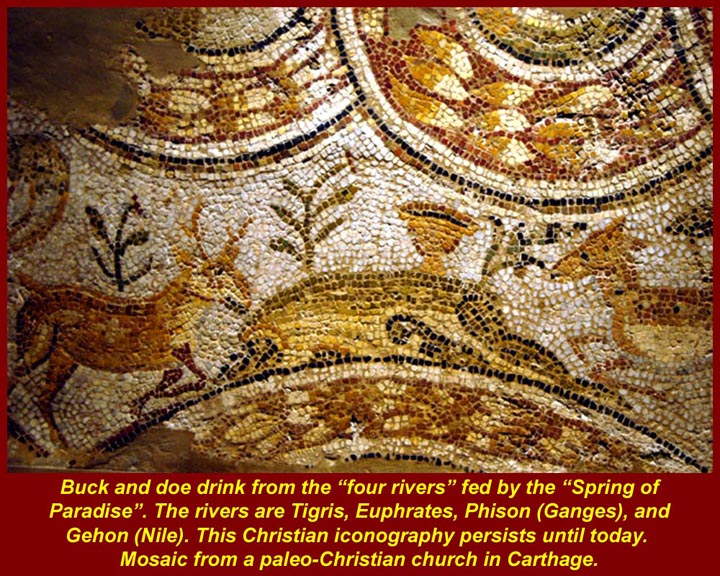
http://www.mmdtkw.org/CNAf0928Carthage4Rivers.jpg
A "four rivers" mosaic from a Christian church in Carthage.
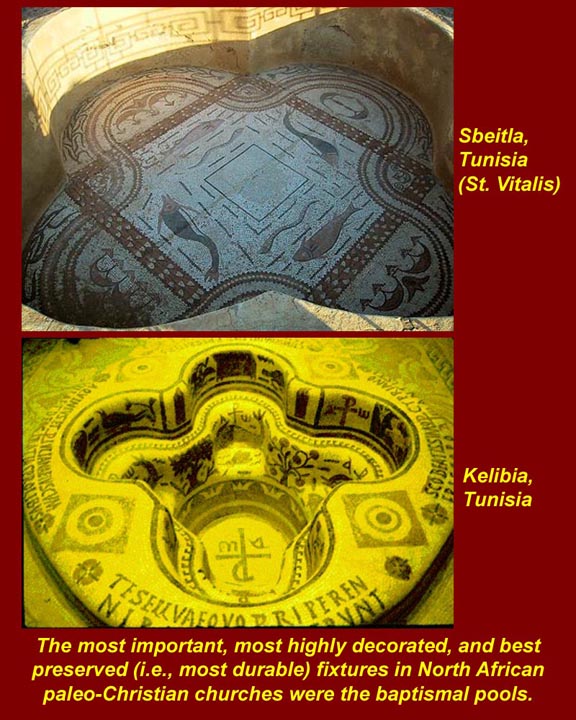
http://www.mmdtkw.org/CNAf0929BaptismalPools1.jpg
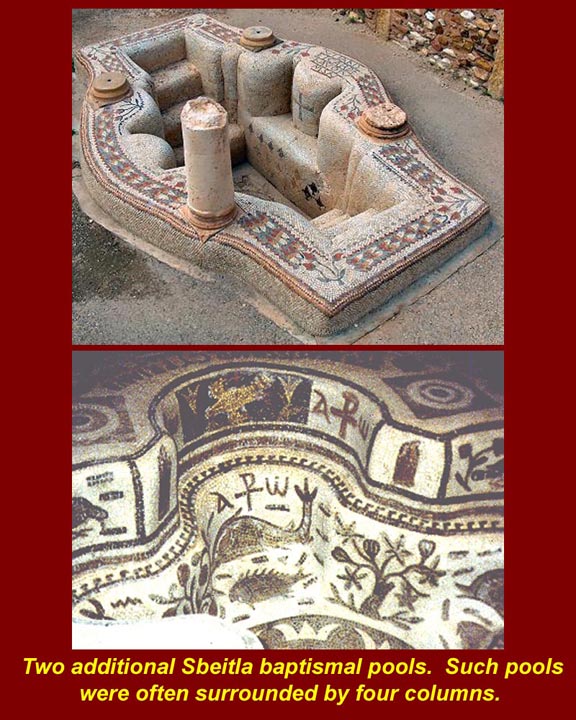
http://www.mmdtkw.org/CNAf0930BaptismalPools2.jpg
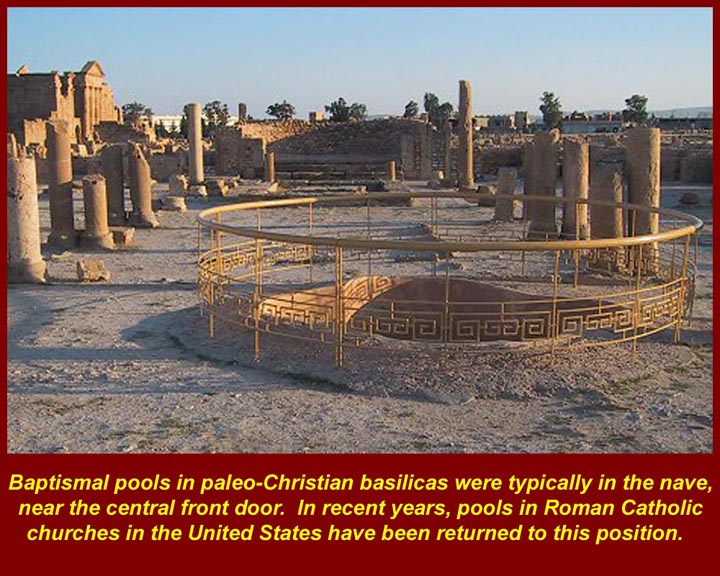
http://www.mmdtkw.org/CNAf0931SbeitlaNavePoolSVitalis.jpg
Large ornate baptismal pools were another unique characteristic of northern African Christian churches.
